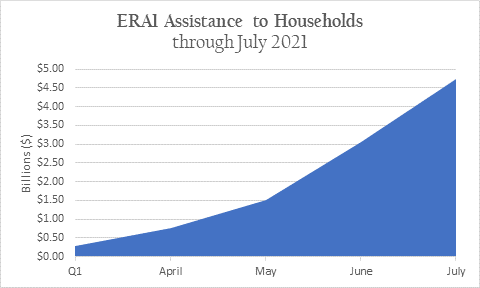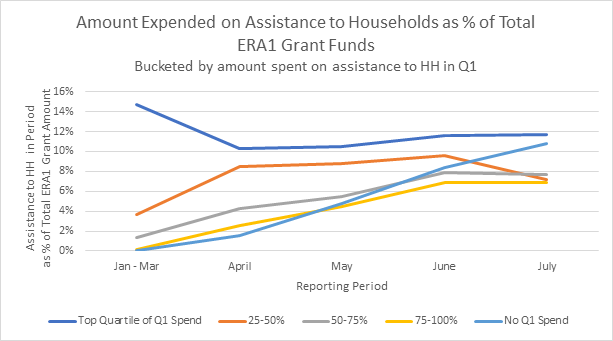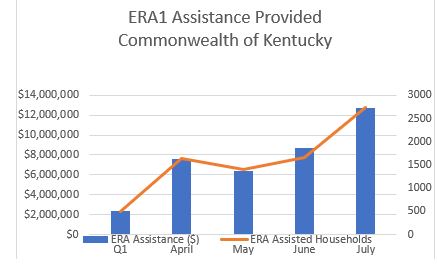Latest Treasury Data Shows Continued Progress; About 1 Million Payments Made by State and Localities as of July 31
New data on program performance demonstrates steady improvement in delivering Emergency Rental Assistance (ERA) to eligible households – particularly among state and local agencies that adopted the recommendations in Treasury’s prior guidance. Even with these improvements, many grantees need to do more to urgently accelerate efforts to prevent harmful evictions of vulnerable families. To help grantees continue to expedite assistance, today Treasury is announcing additional policies – including measures to reduce processing delays by providing even more explicit permission for grantees to rely on applicant’s self-attestations without further documentation.
State and local programs have spent more than $5.1 billion to support the housing stability of vulnerable renters out of the $25 billion allocated under the first round of ERA (ERA1). Since January, state and local programs have made about 1 million payments benefitting households at risk of eviction. In July alone, more than 340,000 households received nearly $1.7 billion in rental and utilities assistance, a roughly 15% increase in households served compared to June, and more than double the number of households served in May. The latest data also demonstrates that ERA funds reached the lowest income tenants, with more than 60 percent of households served falling at or below 30 percent of area median income. Many programs have shown an ability to aid vulnerable households quickly, with 70 state and local agencies having expended more than half of their ERA1 allocation assistance to eligible households by the end of July. However, too many grantees have yet to demonstrate sufficient progress in getting assistance to struggling tenants and landlords. After September, programs that are unwilling or unable to deliver assistance quickly will be at risk of having their rental assistance funding reallocated to effective programs in other high-need areas.
Treasury continues to use every lever at its disposal to urge states to distribute assistance to renters and landlords swiftly. From the first weeks of the Administration, Treasury actions have allowed for the accelerated delivery of ERA and encouraged grantees to avoid or reduce unduly burdensome documentation requirements for verifying income, provide assistance directly to tenants when landlords are not cooperative, and protect renters from eviction after payments are made on their behalf. Based on identified challenges and feedback from stakeholders and practitioners, Treasury issued guidance in February, May, and June; and again today.
One of the biggest challenges many state and local government programs continue to face in getting assistance to renters and landlords is application processing delays. According to public dashboards, hundreds of thousands of applications are in the pipeline beyond those that have already been paid. Today, based on feedback collected through site-visits and meetings with rental assistance administrators, tenant advocates, landlords and other stakeholders, Treasury is providing further policy clarity and recommendations meant to accelerate assistance to those in the pipeline in addition to those who have yet to apply, including clarifying that:
- Self-attestation can be used in documenting each aspect of a household’s eligibility for ERA, including with respect to: a) financial hardship, b) the risk of homelessness or housing instability, and c) income. The use of self-attestation for documenting household eligibility clearly speeds up the processing of applications for rental assistance. Treasury is providing even greater clarity and specificity regarding the use of self-attestation and is encouraging grantees to simplify application processes to use self-attestation when other forms of documentation are not immediately available.
- During the public health emergency, state and local ERA programs may rely on self-attestation alone to document household income eligibility when documentation is not available. During the public health emergency, in order to rapidly provide assistance, Treasury is clarifying that grantees may rely solely on a self-attestation of income when applicants are unable to provide other documentation of their income.
- State and local grantees may advance assistance to landlords and utility providers based on estimated eligible arears. To speed assistance, Treasury is establishing guidelines for providing a portion of estimated bulk payments to landlords and utility providers in anticipation of the full satisfaction of application and documentation requirements. These changes balance the need to assist households served by larger landlords and utilities with the need to protect taxpayers.
- State and local grantees may enter into partnership with nonprofits to deliver advance assistance to households at risk of eviction while their applications are still being processed. Where an expedited payment could reasonably be viewed as necessary to prevent an eviction that may occur under a grantee’s standard application process, Treasury is establishing guidelines for state and local programs to engage with non-profit organizations able and willing to take on the financial risk of advancing assistance prior to an application being fully processed to speed aid to at-risk households.
- Grantees may make additional rent payments to landlords that take on tenants facing major barriers to securing a lease, including those who have been evicted or experienced homelessness in the past year. State and local ERA programs may make an additional payment required as a condition for entering into a lease with a “hard-to-house” household that would not otherwise qualify under a pre-existing and lawful screening or occupancy policy.
- Past arrears at previous addresses may be covered. To remove barriers a household may face in accessing new housing if they have outstanding debt in collection, Treasury’s guidance makes clear that state and local grantees may—at an eligible tenant’s request—provide assistance to cover remaining rental or utility arrears at a previous address.
- A tenant’s costs associated with obtaining a hearing or appealing an order of eviction may be covered with ERA funds as an eligible “other expense.” Many states and localities require tenant payments of rent to a court on behalf of the landlord (often referred to as “rent bonds”) as a condition for a tenant to have the opportunity to defend herself in court before being evicted. New guidance makes clear that rent bonds are an eligible ERA expense.
Treasury recognizes that early on, many state and local governments faced a difficult task in building the assistance infrastructure needed to get ERA funds quickly to eligible households from scratch. However, July data shows many have done this successfully and several communities have reported fully spending their ERA 1 resources, demonstrating that there are effective pathways to getting relief quickly to those who need it.
Today, Deputy Secretary of the Treasury Wally Adeyemo communicated in a letter to all grantees the following:
- Treasury, in line with communications from the Department of Justice, strongly encourages jurisdictions to follow the lead of states and cities that are putting in place added protections against evictions, including for renters who have applied for assistance but have not yet had their applications processed.
- Treasury, in coordination with our partners, is prepared to send out a next round of technical assistance providers to help ERA grantees strengthen their programs.
- If grantees are unable or unwilling to deliver ERA1 resources, Treasury is prepared to reallocate funds. Beginning September 30, 2021, the ERA1 statute requires Treasury to recapture excess funds that have not been obligated by a state or other grantee and reallocate those resources to high-performing jurisdictions that have obligated at least 65% of their original allocation.
Key Findings from the Second Interim Report and July Monthly Report

- Early top spenders are seeing monthly assistance level-off, while programs who were slow to distribute funds have seen a ramp up in assistance to households and landlords
In July, some of the programs that distributed the most assistance in May and June saw spending level off for a variety of reasons. Many programs, including Texas, attribute the leveling off to having fully addressed existing application backlogs. Other grantees are using the last of their ERA1 funds and transitioning to the use of ERA2 funds, which are not included in this reporting data. Grantees have had access to 40 percent of their allotted ERA2 funds since May and have access to additional allotments as they spend the currently available funds.
At the same time, many programs that were slower to distribute assistance in prior months saw notable increases this month as the investments they made in developing infrastructure paid off. For example, administrators of North Carolina’s program say their earlier efforts to build program infrastructure that takes advantage of self-attestation flexibilities has led to increased spending in past few months. This program infrastructure allowed North Carolina to conduct statewide outreach efforts that they say has led to an increase in distribution of rental assistance to households.

- II. Programs following Treasury’s guidance deliver more assistance, faster
Many of the best performing state and local government programs attribute their ability to scale their programs and meet the need in their communities to their adoption of Treasury’s recommendations and guidance. These programs are delivering more assistance, faster. For example, though the state of Kentucky was able to demonstrate some early successes in providing rental assistance within the state, the program has shown consistent grown, most recently assisting 65% more households in July than in June. Program administrators attribute the recent growth to implementing income-based proxies in combination with self-attestation into their application process, which cut their processing time in half. The state’s program is also highly coordinated with the direct grantees in Lexington and Louisville, and program administrators have noted that implementing this strategy has helped to accelerate application processing, reducing backlogs, and promising much quicker application turn-around in the future.

The Treasury blog post is also available for download here.
The July Emergency Rental Assistance data set can be found here.
